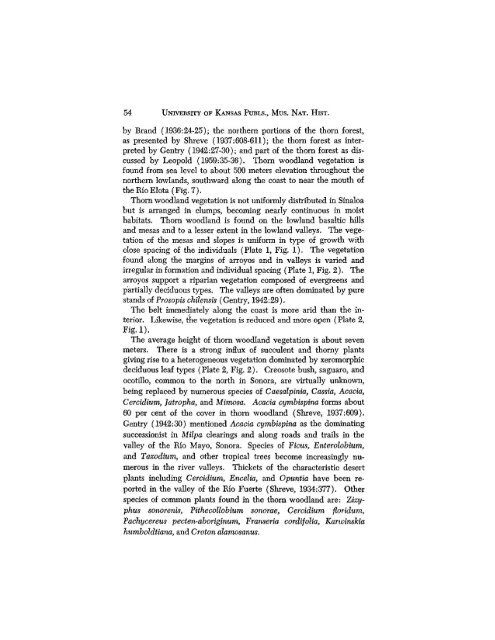The Amphibians and Reptiles of Sinaloa, Mexico - Smithsonian ...
The Amphibians and Reptiles of Sinaloa, Mexico - Smithsonian ...
The Amphibians and Reptiles of Sinaloa, Mexico - Smithsonian ...
Create successful ePaper yourself
Turn your PDF publications into a flip-book with our unique Google optimized e-Paper software.
54 UNIVERSITY OF KANSAS PUBLS., MUS, NAT. HIST.<br />
by Br<strong>and</strong> (1936:24-25); the northern portions <strong>of</strong> the thorn forest,<br />
as presented by Shreve (1937:608-611); the thorn forest as interpreted<br />
by Gentry (1942:27-30); <strong>and</strong> part <strong>of</strong> the thorn forest as discussed<br />
by Leopold (1959:35-36). Thorn woodl<strong>and</strong> vegetation is<br />
found from sea level to about 500 meters elevation throughout the<br />
northern lowl<strong>and</strong>s, southward along the coast to near the mouth <strong>of</strong><br />
theRioEIota(Fig. 7).<br />
Thorn woodl<strong>and</strong> vegetation is not uniformly distributed in <strong>Sinaloa</strong><br />
but is arranged in clumps, becoming nearly continuous in moist<br />
habitats. Thorn woodl<strong>and</strong> is found on the lowl<strong>and</strong> basaltic bills<br />
<strong>and</strong> mesas <strong>and</strong> to a lesser extent in the lowl<strong>and</strong> valleys. <strong>The</strong> vegetation<br />
<strong>of</strong> the mesas <strong>and</strong> slopes is uniform in type <strong>of</strong> growth with<br />
close spacing <strong>of</strong> the individuals (Plate 1, Fig. 1). <strong>The</strong> vegetation<br />
found along the margins <strong>of</strong> arroyos <strong>and</strong> in valleys is varied <strong>and</strong><br />
irregular in formation <strong>and</strong> individual spacing (Plate 1, Fig. 2). <strong>The</strong><br />
arroyos support a riparian vegetation composed <strong>of</strong> evergreens <strong>and</strong><br />
partially deciduous types. <strong>The</strong> valleys are <strong>of</strong>ten dominated by pure<br />
st<strong>and</strong>s <strong>of</strong> Prosopis chilensis (Gentry, 1942:29).<br />
<strong>The</strong> belt immediately along the coast is more arid than the interior.<br />
Likewise, the vegetation is reduced <strong>and</strong> more open (Plate 2,<br />
Fig.l).<br />
<strong>The</strong> average height <strong>of</strong> thorn woodl<strong>and</strong> vegetation is about seven<br />
meters. <strong>The</strong>re is a strong influx <strong>of</strong> succulent <strong>and</strong> thorny plants<br />
giving rise to a heterogeneous vegetation dominated by xeromorpbic<br />
deciduous leaf types (Plate 2, Fig. 2). Creosote bush, saguaro, <strong>and</strong><br />
ocotillo, common to the north in Sonora, are virtually unknown,<br />
being replaced by numerous species <strong>of</strong> Caesalpinia, Cassia, Acacia,<br />
Cercidium, Jatropha, <strong>and</strong> Mimosa. Acacia cymbispina forms about<br />
60 per cent <strong>of</strong> the cover in thorn woodl<strong>and</strong> (Shreve, 1937:609).<br />
Gentry (1942:30) mentioned Acacia cymbispina as the dominating<br />
successionist in MUpa clearings <strong>and</strong> along roads <strong>and</strong> trails in the<br />
valley <strong>of</strong> the Rio Mayo, Sonora. Species <strong>of</strong> Ficus, Enterolobium,<br />
<strong>and</strong> Taxodium, <strong>and</strong> other tropical trees become increasingly numerous<br />
in the river valleys. Thickets <strong>of</strong> the characteristic desert<br />
plants including Cercidium, Encelia, <strong>and</strong> Opuntia have been reported<br />
in the valley <strong>of</strong> the Rio Fuerte (Shreve, 1934:377). Other<br />
species <strong>of</strong> common plants found in the thorn woodl<strong>and</strong> are: Zizyphus<br />
sonorenis, Pithecollobium sonorae, Cercidium floridum,<br />
Pachycereus pecten-aboriginum, Franseria cordifolia, Karwinskia<br />
humboldtiana, <strong>and</strong> Croton alamosanus.
















